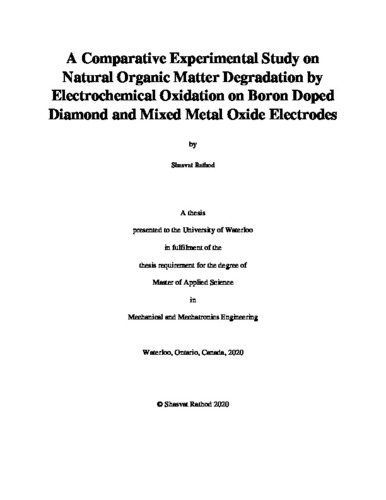UWSpace will be migrating to a new version of its software from July 29th to August 1st. UWSpace will be offline for all UW community members during this time.
A Comparative Experimental Study on Natural Organic Matter Degradation by Electrochemical Oxidation on Boron Doped Diamond and Mixed Metal Oxide Electrodes
| dc.contributor.author | Rathod, Shasvat | |
| dc.date.accessioned | 2020-10-26 18:06:46 (GMT) | |
| dc.date.available | 2020-10-26 18:06:46 (GMT) | |
| dc.date.issued | 2020-10-26 | |
| dc.date.submitted | 2020-08-25 | |
| dc.identifier.uri | http://hdl.handle.net/10012/16466 | |
| dc.description.abstract | Natural organic matter (NOM) pollutants have complexified water treatment facilities and their direct methods for water disinfection. Furthermore, untreated NOM in water networks can lead to property damage in water plumbing and drainage systems, taste and odor challenges, color, bacterial growth in the water distribution systems, and formation of carcinogenic disinfection by-products. Electrochemical treatments, through the production of oxidative species such as OH·, can mineralize organic pollutants. Additionally, electrochemical treatments are useful for the removal of various new age (growing prominent in the last 20 years) pollutants such as phenolic compounds, synthetic dyes, pesticides and drugs, surfactants, and industrial wastewater. In recent years, BDD electrodes have received considerable attention for nonselective NOM removal. Nonetheless, due to the difficulties of NOM characterization and lack of universal standards of measurements for NOM degradation, BDD electrodes have lagged behind for large scale applications. The adoption of an electrochemical technology as an effluent treatment must consider some aspects in order to make its implementation feasible, such as but not limited to performance of anode material and energy consumption. Therefore, a detailed study of NOM removal by BDD electrodes is necessary for long-term goals with BDD anode electrochemical treatment. Firstly, this study directly compares BDD electrode performance for NOM oxidation to widely documented mixed-metal oxide anodes (MMO, dimensionally stable anodes). Three treatment setups were tested in batch mode, recorded as (M1) BDD anode and BDD cathode, (M2) BDD anode and stainless-steel cathode, and (M3) MMO anode and stainless-steel cathode. In an attempt to provide a complete discussion, several NOM characterization methods were utilized: total organic compound (TOC), chemical oxygen demand estimated by peCOD (COD), ultraviolet at the 254 nm wavelength (UV254), specific ultraviolet absorbance (SUVA), specific energy consumption, and COD/TOC ratio. The performance was successfully gauged under several parameters such as initial pH, duration of electrolysis, and applied current density. Secondly, a 2nd order box-benkhen design (BBD) was employed to optimize and investigate the effects of process variables. The response surface methodology (RSM) optimized the following operating conditions: initial pH (6.5 – 8.5), electrolysis time (30 – 120 mins), and applied current density (10 – 30 mA cm-2). All the statistical analyses were performed by Stat-ease Design Expert 8.0.7.1 statistical software package (Stat-Ease Inc., Minneapolis, USA). Although the MMO electrode had better performances at lower current densities of 10 mA cm-2 between the 0 to 30-minute range, the removal efficiencies concretely determined that BDD electrodes exhibited higher oxidation under a broader range of operating conditions such as higher current density, increased duration, and broader pH ranges. Additionally, BDD electrodes consumed energy efficiently and outperformed MMO electrodes at higher current densities and pH, reaffirming its low capacitance and electrochemical stability. Furthermore, peCOD/TOC ratios and SUVA values determined BDD electrodes are more effective at NOM breakdown. Derringer’s optimization techniques from the BBD configuration presented electrolysis time and applied current density to have a significant effect on the electrochemical process. Whereas initial pH was confirmed to have a minimal effect on NOM removal. Pareto analysis of variance suggested peCOD estimations were not indicative for NOM and, TOC along with SUVA, provided a stronger estimation. 3D contour plots identified different mechanisms dictated NOM removal based on electrode type and pollutant. M1 and M2 (BDD anodes) were largely unaffected by initial pH, whereas longer electrolysis duration and larger applied current densities drastically improved NOM removal. On the other hand, M3 (MMO anodes) reduced in performance, at higher pH, after an electrolysis duration of 60 minutes, and reached maximum SUVA at low applied current density. In summary, the electrooxidation process shows promise for large scale applications to treat NOM wastewater with high removal efficiencies by monitoring electrochemical electrolysis duration and applied current density. However, the lack of a universal method of NOM characterization proposes difficulties for NOM monitoring. TOC, COD, and SUVA predicted different trends as NOM involves a complex matrix of aromatic compounds, molecular weights, and organic macromolecules. Therefore, research for a comprehensive NOM characterization method will propel the application of BDD anodic electrochemical oxidation. Additional studies to research BDD behavior under a more extensive range of operating conditions are required to maximize the removal of organics in water. | en |
| dc.language.iso | en | en |
| dc.publisher | University of Waterloo | en |
| dc.subject | Electrochemical Treatment | en |
| dc.subject | Boron-doped Diamond | en |
| dc.subject | Natural Organic Matter | en |
| dc.subject | Water Treatment | en |
| dc.subject | Box-Behnken Design | en |
| dc.title | A Comparative Experimental Study on Natural Organic Matter Degradation by Electrochemical Oxidation on Boron Doped Diamond and Mixed Metal Oxide Electrodes | en |
| dc.type | Master Thesis | en |
| dc.pending | false | |
| uws-etd.degree.department | Mechanical and Mechatronics Engineering | en |
| uws-etd.degree.discipline | Mechanical Engineering | en |
| uws-etd.degree.grantor | University of Waterloo | en |
| uws-etd.degree | Master of Applied Science | en |
| uws.contributor.advisor | Zhou, Norman | |
| uws.contributor.affiliation1 | Faculty of Engineering | en |
| uws.published.city | Waterloo | en |
| uws.published.country | Canada | en |
| uws.published.province | Ontario | en |
| uws.typeOfResource | Text | en |
| uws.peerReviewStatus | Unreviewed | en |
| uws.scholarLevel | Graduate | en |

